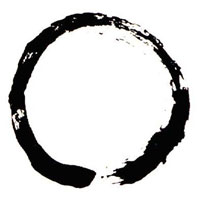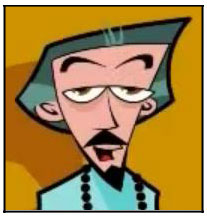The Gateless Gate
The common theme of the kōans is the inquiry and introspection of dualistic conceptualizations (eg, spirit and matter, mind and body, mysticism and sensuality, unity and multiplicity, conformity and individualism). The essence of the kōans is to shed light on the polarities of consciousness that are obstacles to insight. The student is challenged to transcend the polarity and to demonstrate his or hers transcendence to the Zen master. Joshu's
Dog
Mu is the single most common character in the entire Chinese Buddhist canon. It translates to 'no', 'not', 'without', 'nothing' or 'nonexistence'. The same character is seen at the end of verse 40 of the Tao Te Ching where the line translates to "existence emerges from nonexistence". The Joshu's Dog koan is a challenge to demonstrate one's Buddha-nature without becoming entangled in doctrine. In the Book of Serenity, Zhaozhou's reply is neither affirmation nor negation, for he answers "no" to one monk and he says, "yes" to another. Yasutani Haku'un of the Sanbo Kyodan takes the position: "the kōan is not about whether a dog does or does not have a Buddha-nature because everything is Buddha-nature, and either a positive or negative answer is absurd because there is no particular thing called Buddha-nature." The famous comparative religion scholar and interpreter of Zen Buddhism, Dr. Alan Watts, explores the theme of the "Great Doubt" (excerpt from his popular radio lecture),
"The key difference between Hinduism and Buddhism is identity. Well who is it who desires not to desires? Who is it that wants to escape from suffering? The Hindu says, 'you, yourself, atman – the self strive to know the self. Realize I am not my body because I can be aware of my body. I am not my thoughts because I can be aware of my thoughts. I am not my feelings, but cause I am aware of my feelings. I am above – transcending'". "The Buddhist has a critique of that. He says, “Why do you try to escape from yourselves as a body?” The reason is your body falls apart and you want to escape from it. Why do you want to dis-identify yourself from your emotions? The reason is that your emotions are uncomfortable and you want to escape from it. You don’t want to have to be afraid. You don’t want to be in grief or anger. And love is too much, because it involves you in suffering. If you love someone you have a hostage to fortune. So the Buddhist says, 'the reason why you believe you are the atman – the eternal self – which in turn is the Brahman, the self of the whole universe, is that you don’t lose your damn ego'. 'If you can fix your ego, put it in a safe deposit box of the Lord, you think you still got yourself, you haven’t really let go'. So the Buddhist says there isn’t any atman – he taught the doctrine of an-atman or non-self. Your ego is unreal and as a matter of fact there is nothing you can cling to. No refuge. Just let go, man. No salvation, no safety, nothing anywhere". "See how clever that was. Because what he was really saying is, “any atman you could cling to or think about or believe in, it wouldn’t be the real one”. This is the accurate sense of the original documents of the Buddhist teaching. In short, anything you could conceive, it couldn’t be it. Anyone you believe in would be the wrong one, because believing is clinging. There is no salvation through believing. There is only salvation through knowledge. And even then, the highest knowledge is ‘non-knowledge’ and here he agrees with the Hindu, saying “If you think that you know Brahman, you do not know him”. But if you know that you don’t know the Brahman, then you truly know.” Why? If you really are it then you don’t need to believe in it. Just like your eyes don’t need to look at themselves." "That’s the difference of method in Buddhism. The method is a dialog. The so called teachings of Buddhism are first opening gambits in the dialog. When they say you cannot understand Buddhism out of books, the reason is that the books only give you only the opening gambits. Then having read the book you have to go on with the method. Now you can go on with the method without a formal teacher – you can conduct the dialog with yourself. Or with life. You have to explore and experiment on such things as could one possibly not desire? Could one possibly concentrate the mind perfectly? The latter things are the heart of Buddhism." "The dialog led to great universities. One could claim that all the dialog was one big bull session, where philosophers were outwitting each other. Actually the process that was going on was this: that the teacher or guru in every case was examining students as to their beliefs and theories and destroying their beliefs. Showing that any belief that you proposed, any idea about yourself or the universe that you want to cling to and make something of to use for a crutch, a prop or security, the teacher demolishes. This is how the dialog works. Until you are left without a thing to hang onto. Any religion you might propose, even atheism, the teacher will tear up. They will destroy agnostism. Any kind of belief – the teacher is an expert in demolition. So they finally get you to the point where you got nothing left to hang on to. So you are free, because you’re it. Once you’re hanging on to things, you put it somewhere else. Something I can grab. And even when you think, as an idea, then I am it, you’re still hanging on to that and so the teacher will knock that one down. So when you are left without anything at all, you’ve seen the point. So that’s the method of the dialog – the dharma. And all Buddhist make jokes about it." Buddhist says in the Dharma-sutra, “When I attain complete, perfect, unsurpassed awakening I didn’t attaint anything.” Because it’s like using an empty fist to deceive a child. So you say to a child what have I got here? The child becomes very curious and wrestles with your hand. So you open it an there is nothing."
z |


